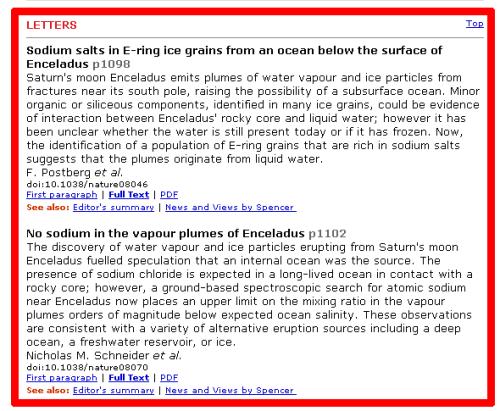![]() It seems that there is at least one person in the Nature office with a sense of humour: two contradictory answers to the same question, published one after the other in the same issue.
It seems that there is at least one person in the Nature office with a sense of humour: two contradictory answers to the same question, published one after the other in the same issue.

The plumes of vapour being emitted from the south pole of the Saturnian moon Enceladus have been causing a fair amount of excitement in the past couple of years. However, it’s still unclear exactly where this vapour is coming from. Could it be coming from an extensive sub-surface ocean, or from smaller, isolated melt pockets just beneath the surface? One way of distinguishing between these two possibilities is to look for sodium salts in the vapour. If it’s coming from a deep subsurface ocean, it should contain sodium salts leached from rock silicates of Enceladus’ core. If the source is shallow, the plumes’ composition should be much closer to pure water.
And here we have two searches for sodium yielding different results: Schneider et al., using ground based telescopes, don’t see and suggest that sodium salts can only exist in very low concentrations; in contrast, Postberg et al. have directly analysed particles collected by Cassini and find that a subset of them are indeed rich in sodium salts. The latter authors explain away the contradition by suggesting that the sodium rich particles might mostly fall back onto the Moon’s surface.
It appears that assessing the significance of these results might be tricky. Although the ultimate source of the sodium might be through chemical exchange with a rocky core, that exchange – and the transfer of salts to the surface – could easily have happened a long time ago – ancient ice volcano eruptions contaminating the purer ice closer to the moon’s surface (and if salt-rich particles are falling to the surface today, that complicates things even further). Although a nice sub-surface ocean would cause (oh sorry – is causing) the water=life brigade to erupt in yet another of their paroxysms of premature joy , I think there’s a bit more argument to be had yet.
Postberg, F., Kempf, S., Schmidt, J., Brilliantov, N., Beinsen, A., Abel, B., Buck, U., & Srama, R. (2009). Sodium salts in E-ring ice grains from an ocean below the surface of Enceladus Nature, 459 (7250), 1098-1101 DOI: 10.1038/nature08046
Schneider, N., Burger, M., Schaller, E., Brown, M., Johnson, R., Kargel, J., Dougherty, M., & Achilleos, N. (2009). No sodium in the vapour plumes of Enceladus Nature, 459 (7250), 1102-1104 DOI: 10.1038/nature08070



Comments (1)